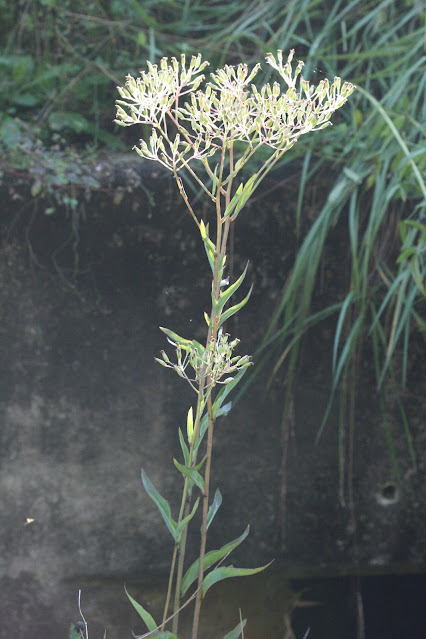Monday, May 26, 2025
Georgia Indian Plantain - Arnoglossum sulcatum
Variable-leaf Indian Plantain - Arnoglossum diversifolium
Variable-leaf Indian plantain (Arnoglossum diversifolium) is another one of the six Indian plantains native to Florida and one of the tallest. Although this perennial dies back to the ground in winter, it quickly reaches its mature height of up to 10 feet by early summer. Native to six central Panhandle counties and two in north Florida, it also is vouchered from Alabama and Georgia. Throughout this rather limited region is occurs in swamps, wet hardwood hammocks, openings in floodplain forests over limestone with clayey, basic soils and a canopy of hardwood trees and bald cypress.
As its Latin and common name implies, its leaves are variable. The lower leaves are heart-shaped with squared off bases and blades up to 4 inches long. The leaves alternate up the stem and become reduced in size and more deeply toothed with very short petioles or none at all. Flowering occurs atop the single stem in summer. The urn-shaped white flowers are tinged in pink. These are attractve to a variety of pollinators - especially bees.
Variable-leaf Indian plantain is listed as threatened in both Florida and Georgia and few populations currently occur on protected lands. Although an interesting and useful plant ecologically, it is not a good candidate for cultivation for home landscapes and has never been offered commercially by nurseries associated with FANN - the Florida Association of Native Nurseries. It simply is one of many native plants to be admired if found while walking in a natural wetland.
These photos were taken by my friend, Floyd Griffith and are used with permission.
Sunday, May 25, 2025
White Tick-trefoil - Desmodium ochroleucum
Very little seems to have been written about it and I have no personal experience with it. These photos were taken by my friend, Floyd Griffith and used by permission.
White indian Plantain - Arnoglossum album
Indian plantains (Arnoglossum spp.) are members of the Asteraceae and are most common in the Southestern U.S. Of the 8 species native to North America, 6 occur in Florida and two of these are endemic. White Indian plantain (A. album) is one of these. Classified as "rare", it has been vouchered from just a few counties in the northwestern Panhandle. Here, it is native to wet savannas.
Indian plantains are perennials that die back to the ground each winter and reemerge again in spring as a basal rosette of thick deep-green leaves. In white Indian plantain, these leaves are elongated with pointed teeth along the margins. Once established, the plants send up an individual flower stalk that can reach just more than three feet tall. The leaves along this stalk are alternate, eliptical and sharply toothed along the margins. Like other members of this genus the flowers are produced in flattened heads atop the stalk. In white Indian plantain, they are the typical white in color and funnel shaped, but they occur in fewer numbers than its relatives. They attract the attention of a great diversity of pollinating invertebrates.
As a very rare endemic, restricted to sunny wet habitats, white Indian plantain is not a good candidate for commercial growers and has never been offered for sale by nurseries associated with FANN - the Florida Association of Native Nurseries. Several upland species are, however, This is one of the great many species native to Florida that simply should be admired if encountered.
These photos were taken by my friend, Lily Byrd, and used by permission.
Plukenet's False Foxglove - Agalinis plukenetii
There are 17 native species of false foxgloves (Agalinis spp.) in Florida and they are often difficult to identify. Much of it depends on growth habit and on the foliage. Plukenet's false foxglove (A. plukenetii) is characterized by its mounding habit and its very thin recurving leaves. This species was not recognized as such in my earlier versions of the Guide to the Vascular Plants of Florida (Wunderlin and Hansen), but is included by the 3rd Edition. Like most false foxgloves, Plukenet's is an annual that appears in spring and grows rapidly to the bush form it exhibits by late summer. The flowers are typical for the genus - five pink petals with a frill along the outer edge and pink spots in the throat. This species flowers profusely by late summer and fall and attracts the attention of pollinators - especially bees..
Plukenet's false foxglove occurs throughout much of north and central Florida in dry to xeric, sandy, gravelly or clay roadsides, pine-oak forests, margins of savannas, and disturbed ground. Like other members of this genus, it serves as a host plant for the common buckeye butterfly but has never been offered commercially by any of the native plant nurseries in Florida associated with FANN - the Florida Association of Native Nurseries. As a root parasite that needs to attach its root system early to a host plant and because it's also an annual, it is not a good candidate for a typical home landscape. It is easily germinated, however, from ripe seed collected once the seed capsules mature.
These photos were taken by my friend, Steve Coleman, and used by permission.


















